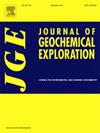埃塞俄比亚北部mentebteb红土铁矿床的主要、痕量和稀土元素特征
IF 3.3
2区 地球科学
Q1 GEOCHEMISTRY & GEOPHYSICS
引用次数: 0
摘要
稀土元素在Mentebteb红土型铁矿床中的分馏和富集是风化地形中稀土元素勘探的关键过程。本研究利用岩石学分析、x射线粉末衍射(XRD)和地球化学技术(如电感耦合等离子体原子发射光谱法(ICP-AES)和电感耦合等离子体质谱法(ICP-MS))相结合的综合方法,研究了红土风化剖面中稀土元素的分布、迁移率和行为控制。剖面分为三个主要层:红土铁层、富粘土红土层和含铁砂岩层。在红土铁层位,赤铁矿为主要含铁矿物,针铁矿次之,石英、长石、高岭石为辅。地球化学资料显示,稀土元素沿剖面呈差异分异富集,其中铁氧氢氧化物在稀土元素富集中起主要作用,特别是在红土铁层位。Fe、Cr、V、Co、Ni和ΣLREE/ΣHREE比值呈正相关,表明稀土在红土铁层中与Fe相有选择性吸附和共沉淀。而上红土层位Al₂O₃与这些元素的负相关表明粘土矿物对REE的保留作用可以忽略不计。然而,Al₂O₃与V表现出变量相关性(r = 0.27;r =−0.37),Cr (r = 0.61;r =−0.79),Ni (r = 0.52;r =−0.48),Co (r = 0.65;R =−0.52),说明黏土矿物对富粘土层中元素迁移率有影响,但对富粘土层中元素迁移率影响较小。稀土分异模式由La/Y比值在红土铁层位(La/Y <;1, 0.87-0.99),富集于富粘土层(La/Y >;1, 1.08-1.36)和含铁砂岩(La/Y >;1, 1.27 - -1.76)。这些稀土元素分散和分选趋势的变化受风化强度、氧化还原条件、酸溶、矿物分解和差异溶解度效应的控制,这些影响因素驱动浸出、络合和二次富集过程。观察到的稀土元素行为强调了红土化在富集关键金属中的重要性,并为向稀土富集带方向方向提供了地球化学标准。该研究强调了红土化过程在稀土元素聚集中的重要性,并为风化铁矿,特别是红土地的稀土元素勘探提供了框架。本文章由计算机程序翻译,如有差异,请以英文原文为准。
Major, trace, and Rare Earth Element (REE) characteristics of the mentebteb lateritic iron deposit, northern Ethiopia
Rare earth elements (REEs) fractionation and accumulation in Mentebteb lateritic Fe deposits are the key processes with direct implications for REE exploration in weathered terrains. This study investigates the distribution, mobility, and controls on REE behavior across a lateritic weathering profile, using an integrated approach that combines petrographic analysis, X-ray Powder Diffraction (XRD), and geochemical techniques such as Inductively Coupled Plasma Atomic Emission Spectrometry (ICP-AES) and Inductively Coupled Plasma Mass Spectrometry (ICP-MS). The profile is divided into three main horizons: a lateritic iron horizon, a clay-rich lateritic horizon, and ferruginous sandstone. In the lateritic iron horizon, hematite is identified as the dominant Fe-bearing mineral, with subordinate goethite and accessory quartz, feldspar, and kaolinite. The Geochemical data reveal that REEs are differentially fractionated and enriched along the profile, with Fe-oxyhydroxides playing a major role in REE accumulation, particularly in the lateritic iron horizon. The positive correlations between Fe, Cr, V, Co, Ni, and ΣLREE/ΣHREE ratios suggest selective sorption and co-precipitation of REEs with Fe phases in the lateritic iron horizon. In contrast, the negative correlation between Al₂O₃ and these elements in the upper lateritic horizon suggests a negligible role of clay minerals in REE retention. However, Al₂O₃ exhibits variable correlations with V (r = 0.27; r = −0.37), Cr (r = 0.61; r = −0.79), Ni (r = 0.52; r = −0.48), and Co (r = 0.65; r = −0.52) in the clay-rich lateritic and ferruginous sandstone layers, indicating that clay minerals influence element mobility in the clay-rich horizon but have minimal impact in the ferruginous sandstone. REE fractionation patterns is evidenced by La/Y ratios is depleted in the lateritic iron horizon (La/Y < 1, 0.87–0.99) and enriched in the clay-rich horizon (La/Y > 1, 1.08–1.36) and ferruginous sandstone (La/Y > 1, 1.27–1.76). These variations in the REE dispersion and fractionation trends are controlled by weathering intensity, redox conditions, acid dissolution, mineral breakdown and differential solubility effects which drive leaching, complexation, and secondary enrichment processes. The observed REE behavior underscores the importance of lateritization in concentrating critical metals and provides geochemical criteria for vectoring towards REE-enriched zones. This study highlights the importance of lateritization processes in REE accumulation and provides a framework for REE exploration in weathered Fe deposits, particularly in lateritic terrains.
求助全文
通过发布文献求助,成功后即可免费获取论文全文。
去求助
来源期刊

Journal of Geochemical Exploration
地学-地球化学与地球物理
CiteScore
7.40
自引率
7.70%
发文量
148
审稿时长
8.1 months
期刊介绍:
Journal of Geochemical Exploration is mostly dedicated to publication of original studies in exploration and environmental geochemistry and related topics.
Contributions considered of prevalent interest for the journal include researches based on the application of innovative methods to:
define the genesis and the evolution of mineral deposits including transfer of elements in large-scale mineralized areas.
analyze complex systems at the boundaries between bio-geochemistry, metal transport and mineral accumulation.
evaluate effects of historical mining activities on the surface environment.
trace pollutant sources and define their fate and transport models in the near-surface and surface environments involving solid, fluid and aerial matrices.
assess and quantify natural and technogenic radioactivity in the environment.
determine geochemical anomalies and set baseline reference values using compositional data analysis, multivariate statistics and geo-spatial analysis.
assess the impacts of anthropogenic contamination on ecosystems and human health at local and regional scale to prioritize and classify risks through deterministic and stochastic approaches.
Papers dedicated to the presentation of newly developed methods in analytical geochemistry to be applied in the field or in laboratory are also within the topics of interest for the journal.
 求助内容:
求助内容: 应助结果提醒方式:
应助结果提醒方式:


